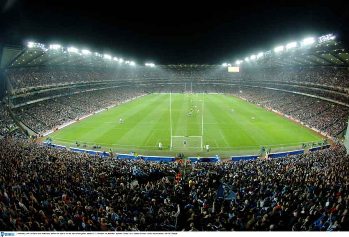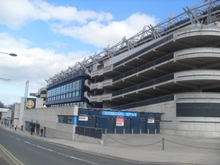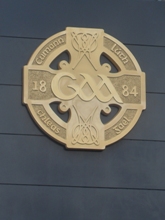"Dublin's Stadia Series 1 - Croke Park" - this cache is one of seven in the series. The stadia are the National stadia for their respective sports.
The series consists of:
| Croke Park Gaelic Football & Hurling |
| The Aviva Stadium Soccer & Rugby |
| The RDS Ballsbridge Show Jumping |
| Morton Stadium Athletics |
| The National Basketball Arena Basketball |
| The National Stadium SCR Boxing |
| The National Aquatic Centre Swimming |
The series will bring you to stadia, both old and new, of Dublin city and will hopefully give you an appreciation for the love of all sport that is alive not only in this city, but in the country in general. The various venues are of different ages and sizes. They are impressive and imposing structures within their surrounding localities.
Croke Park

Croke Park (Irish: Páirc an Chrócaigh) in Dublin, Ireland is the largest sports stadium in Ireland. It is the principal stadium and headquarters of the Gaelic Athletic Association (GAA), Ireland's biggest sporting organisation. "Croker", as it is often called by Dubliners, is in the heart of the city, a 15 minute walk from the main thoroughfare O'Connell Street. With a capacity of 82,300, it is the fourth largest stadium in Europe and the current largest stadium in the Six Nations Championship.
Since 1884 the site has been used primarily by the GAA to host Gaelic games, most notably the annual finals of the All-Ireland Senior Football Championship and Senior Hurling Championship.
History of Croke Park - The site upon which Croke Park now stands was originally owned by Dublin businessman Maurice Butterly. Known as the ‘City and Suburban Racecourse’ in the 1870’s, his most frequent tenant was the GAA. In 1908 Frank Dineen of Limerick, a journalist and former President and Secretary of the GAA, bought the almost derelict site for £3,250. The GAA subsequently purchased the site in 1913 for £3,500 and renamed the ground Croke Park in honour of the association’s first patron, Archbishop Croke of Cashel. Over the next 40 years, Croke Park was developed and redeveloped in an ad hoc manner as finances allowed.
The Railway End, now known as the Dineen Hill 16, was built from the rubble left in Sackville Street (now O’Connell Street) after the 1916 rising. The Hogan Stand built in 1924 was named after Tipperary footballer Michael Hogan, who was fatally shot on the pitch in Croke Park by British troops along with 13 others on Bloody Sunday 1920. The Cusack Stand, named after one of the original founders of the GAA Michael Cusack, followed in 1937. The Canal End terrace, named after the Royal Canal which runs behind it, was developed as a fully terraced facility in 1949, greatly improving the comfort and view for spectators at the southern end of the ground. The construction of the Nally Stand followed in 1952, named after Fenian Pat Nally. Since these initial buildings, reconstruction and redevelopment of various sections of the ground have taken place.

Four Phases of Redevelopment 1995 - 2005
Phase One - demolition of the old Cusack Stand and by summer 1995 the new Cusack Stand became part of the Dublin skyline at a cost of £35 million. The new stand is 180 meters long, 35 meters high, has a capacity for 25,000 people and contains 46 hospitality suites.
Phase Two - demolition of the Canal End Terrace and extension of the new stand completed in time for the 2000 All Ireland finals, started in late 1998 and involved extending the new Cusack Stand. It is now known as The Davin Stand (Irish: Ardán Dáimhím), after Maurice Davin, the first president of the GAA. This phase also saw the creation of a tunnel which was later named the Ali tunnel in honour of Muhammad Ali and his fight in Croke Park.
Phase Three - the Hogan Stand completed the “horseshoe” effect. This required a greater variety of spectator categories to be accommodated including general spectators, corporate patrons, VIPs, broadcast and media services and operation staff. Extras included a fitted-out mezzanine level for VIP and Ard Comhairle (Where the dignitaries sit) along with a top-level press media facility.
Phase Four – construction began in September 2003 replacing the old Hill 16 and Nally Stands with modern terraces that increased the capacity of the stadium to 82,300. This final phase was completed and officially opened by An Taoiseach in March 2005.

Croke Park Plays Host through the Years:
• As far back as 1953 Croke Park hosted a demonstration of American Football in aid of the Irish Red Cross society.
• In the 60’s, the Galahs played Australian Rules Football in the stadium.
• In 1972, the great Muhammad Ali came to Croke Park amidst a fanfare of publicity to defeat Al “Blue” Lewis.
• By the 1980’s, the International Rules series had been established to match the cream of Gaelic football against their counterparts from the Australian Football League.
• Most recently in 2007, the stadium opened its doors to Rugby and Soccer while the Lansdowne Road site is being redeveloped. (On 16 April 2005, a motion to temporarily relax rule #42 was passed, enabling rugby & soccer to be played on GAA pitches. Rule 42 prohibited the use of GAA property for games with interests in conflict with the interests of the GAA.)
• Croke Park has also proudly hosted the opening and closing ceremonies of the Special Olympics World Summer Games in 2003, the first time these events were held outside the United States.
• And of course the stadium has staged concerts featuring great international artists such as Tina Turner, Garth Brooks, Bon Jovi, Billy Joel, Elton John, Robbie Williams and U2.
• It has also held the world record for largest attendance at a club rugby union match since 2 May 2009.


The cache is a micro. Don't forget to bring your own pen.
Stealth is required in this urban location. Please be aware of the many people who pass by this busy spot, and replace the cache exactly as you found it, ensuring it is not visible.